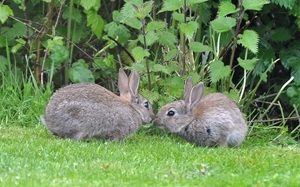The rabbit
 It is quite hard to imagine the British countryside without rabbits bouncing about; however that was once the case, as they in fact originate from the western Mediterranean and were introduced to Britain by the Normans in the 12th century to provide meat and fur. Rabbits were an important part of the Norman diet and were literally farmed in large, enclosed warrens.
It is quite hard to imagine the British countryside without rabbits bouncing about; however that was once the case, as they in fact originate from the western Mediterranean and were introduced to Britain by the Normans in the 12th century to provide meat and fur. Rabbits were an important part of the Norman diet and were literally farmed in large, enclosed warrens.
Of course, a number managed to escape from these enclosures and by the eighteenth century they had become a major pest. The population continued to grow with numbers probably peaking in the mid-1900s at about 100 million, causing an estimated £1 million worth of damage, which was a lot of money in those days! What is interesting is that some 40 million a year were killed, mainly for food and were a significant meat source for most country folk.
But of course the virus myxomatosis was introduced into the south east of England in 1953 and was then carried by fleas from rabbit to rabbit, helped along somewhat by people moving infected animals into “clean” areas. Interestingly, the government refused to ban this activity despite the protests from animal welfare groups. Within two years it was estimated that 99% of the rabbit population had died.
The countryside changed overnight, with areas that had previously had large populations of rabbits and therefore short, heavily nibbled grasslands, suddenly growing lush tall grass. Interestingly this lack of grazing caused many areas to lose important species that had come to rely on the rabbit, such as some important butterfly colonies which require a short grass sward to prosper!
But rabbits are nothing if not resilient and before too long some started to show signs of developing resistance. Nowadays, although outbreaks still occur, the population is once more thriving and growing and is now estimated to be around 40 million. What does not seem to have recovered quite so well is the good old rabbit stew, which is rarely served up in the average rural home. This is a great shame as it a fantastically lean and tasty dish!
If conditions allow, rabbits will breed throughout the year and can produce a litter of 3-7 young (known as kittens) per month. The female “doe” constructs a nest inside a burrow from grass bedding and lines it with soft fur from her chest and belly. Quite often, lower ranking does may be forced to breed in single entrance breeding burrows known as "stops", which are sited away from the main breeding warren. The young kittens are born blind, deaf and almost hairless, unlike the young of brown hare which are born all singing and dancing and ready to go! The kitten’s eyes open at around 10 days and they are weaned at 21-25 days old. The male or buck rabbit can mate at four months old and does can become pregnant at just 3.5 months of age, so you can begin to see how they might quickly make a comeback from something as serious as myxomatosis!
Peter Thompson
Advisory
Read more from Peter Thompson at the Fresh from the Field blog.
View the National Gamebag Census trends for rabbits

Download Peter Thompson's essential 26-page book, featuring beautiful photography and detailed profiles of Britain's wildlife
Download FREE >